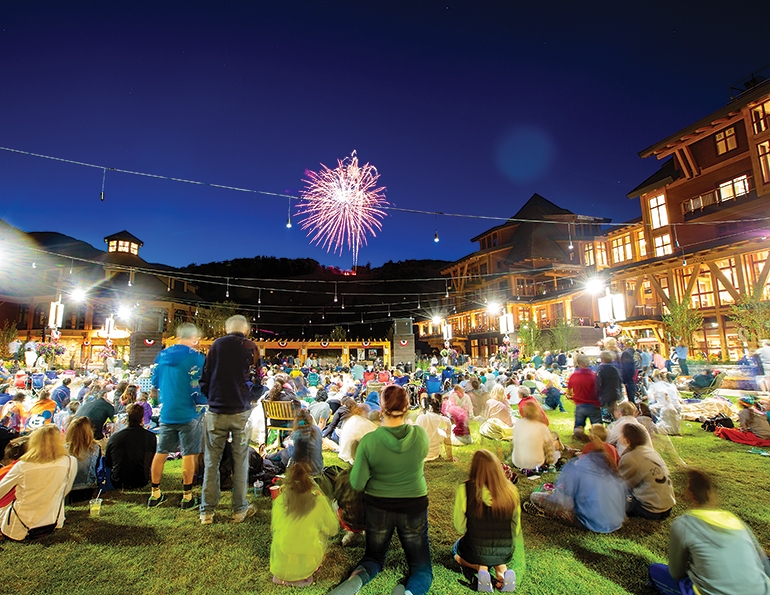Mountain resorts hold a special place in our collective imagination as portals to adventure, residing at the edge of nature and civilization. Base area and village environments provide safe and hospitable launching points for skiing and riding in winter. But now more than ever, these environments play a similar role during the non-winter months. And there are a variety of aesthetic and functional considerations that can make or break green season success.
Growing interest in summer recreation and leisure has increased guest visitation and revenue for many winter resorts, who have developed a range of summer amenities and activities to compete in the crowded outdoor recreation space. This has also expanded opportunities for retail and restaurant business.
Mountain environments are uniquely scenic, and they provide a cool respite from city heat. These inherent advantages enhance the guest experience. But how do our resort environments look and feel after the snow melts? Are guests encouraged to linger? Do they feel comfortable and welcomed? For families visiting the resort, are there comfortable outdoor spaces to sit, relax, and enjoy food and drink while other members of the family ride a zip line or mountain bike?
Attractive Outdoor Spaces
Orient the Visitor
It’s relatively easy for winter guests to figure out where to go once they arrive: park the car, follow the masses to the ticket/rental area, and head for the lift. With the wide variety of activities offered in summer, however, it takes careful design to direct visitors to where they want to go and avoid frustration.
• First step: get visitors to a central information and ticketing hub. There, a well-designed information system, with maps and descriptions of activities, can provide a starting point for exploration.
• There should be logical adjacencies between related outdoor activity areas, and the connections between these different areas should be as clear as possible.
• Prepare accessible paths to provide clearly marked routes between various features. For longer paths, consider providing seating and shade or “pause places” along the way.
• Pedestrian wayfinding signage plays a key role in directing visitors, and these signs present an opportunity to reinforce the resort’s brand.
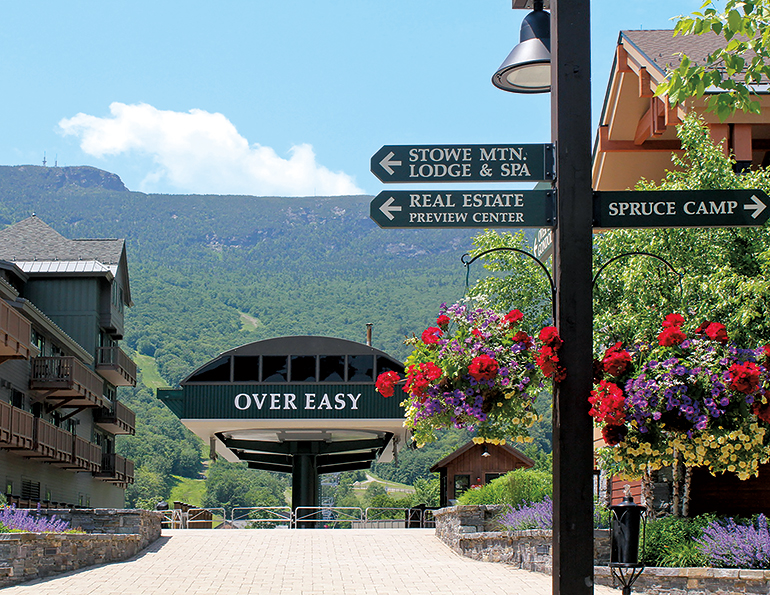 Help guests find their way with clear, consistent signage that is also aesthetically pleasing and on brand. Photo: Stowe Mountain Resort.
Help guests find their way with clear, consistent signage that is also aesthetically pleasing and on brand. Photo: Stowe Mountain Resort.
Reinforce Character and Brand
A tremendous amount of thought goes into establishing a specific character for the buildings in base areas and villages. Extend the same level of care to the landscape and spaces around the buildings, as quality design and materials in the outdoor environment elevate the visitor experience.
• Present a consistent brand or aesthetic from the moment a visitor enters a parking lot to the point at which they venture beyond the base area.
• Materials for paving, walls, and outdoor furnishings should relate to the existing design vocabulary, to present a harmonious aesthetic. The appearance of these elements is critical in the summer, as people are more likely to linger outside, and nothing is hidden by snow.
• The same materials and design style should carry through to smaller support buildings in the landscape as well.
• Use consistent signage and graphics to carry the brand identity throughout all areas of the resort.
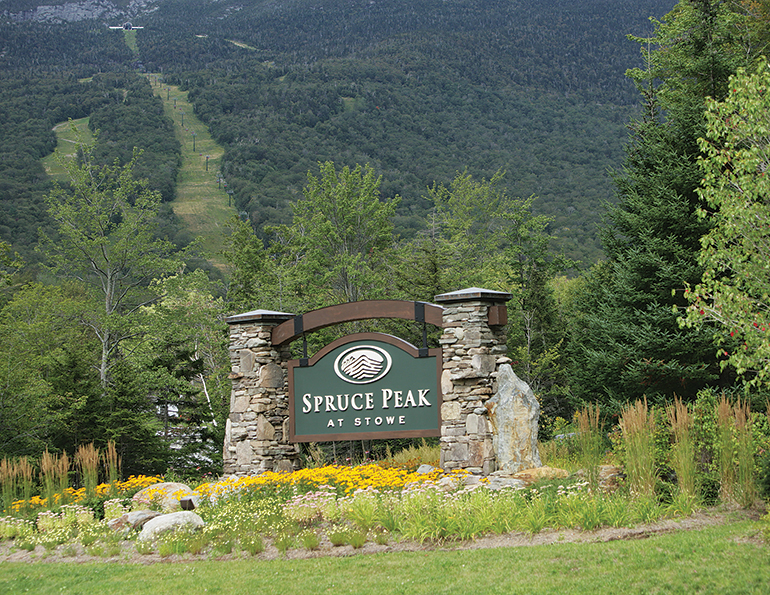 Using the same materials and design in all signage, large and small, create a harmonious aesthetic. Photo: Stowe Mountain Resort.
Using the same materials and design in all signage, large and small, create a harmonious aesthetic. Photo: Stowe Mountain Resort.
Add Some Green!
Base areas designed for winter use often feel desolate, exposed, and less attractive in summer. Robust plantings can enhance the spaces around base and village areas. Successful planting design requires attention to both practical and aesthetic considerations.
• Touches of annual color can be nice in key locations, but larger massings of trees, shrubs, and perennials do more to help visually balance the weight of the buildings.
• Explore opportunities to integrate islands of plantings that don’t impede the functional requirements of winter grooming and peak skier volumes.
• Plantings can soften the appearance of large areas of pavement, and the movement of tall grasses and trees adds life to what can otherwise be an exposed and stark environment in summer.
• In moderate climates such as the Northeast, expanses of green grass have a pleasant aesthetic and provide comfortable gathering areas for large events. Consider flexible space design; open lawns can become winter activity areas with ice skating and snow mounds for winter play.
• While lawns may make sense for outdoor event areas in arid environments, predominant use of native vegetation can make a resort feel more rooted in its natural environment.
• Use of native species brings the context of the surrounding landscape into the developed area and helps reinforce a unique sense of place. Native vegetation often requires less maintenance and irrigation as well.
• Meadows dot the mountain landscape throughout North America. For large areas that aren’t used by the public, native meadow plantings with wildflowers are a sustainable, attractive, and low-maintenance alternative to lawns. Plus, they provide habitat for songbirds and other wildlife.
• For plazas and other pedestrian spaces that are surrounded by tall buildings, elements such as trees and shade structures can provide a transition from vertical building faces and create a human-scaled space that is comfortable for guests to congregate.
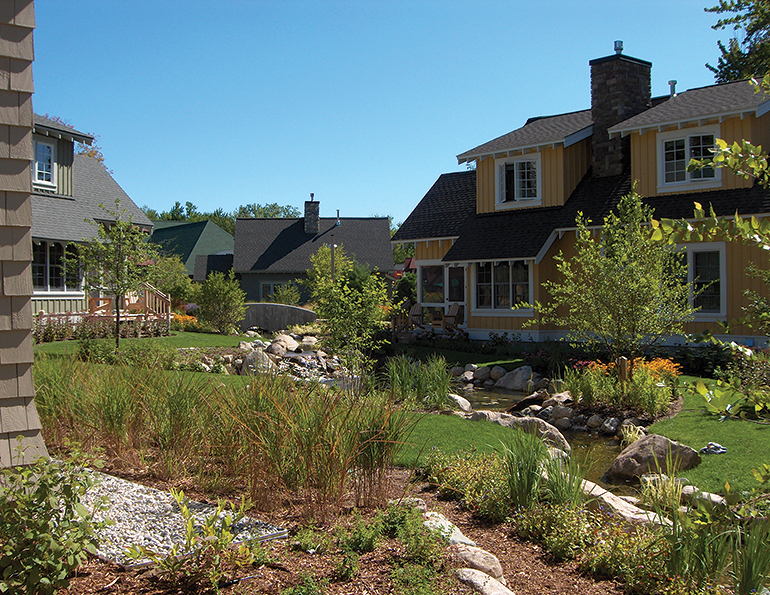 Plantings that incude a variety of trees, shrubs, and perennials add balance and life to spaces.
Plantings that incude a variety of trees, shrubs, and perennials add balance and life to spaces.
Integrate Summer Activities
Careful siting of summer activities can integrate them with the resort experience. Many amenities can feel out of place if developed in open spaces directly adjacent to base and parking areas.
• Make every effort to develop summer activity areas so that they feel like a natural outgrowth of the resort.
• Often, tucking amenities into existing wooded areas creates a more appealing and comfortable atmosphere.
• Take a lesson from successful amusement parks and resorts: Utilize landscaping and seating to create comfortable resting places interwoven with the attractions.
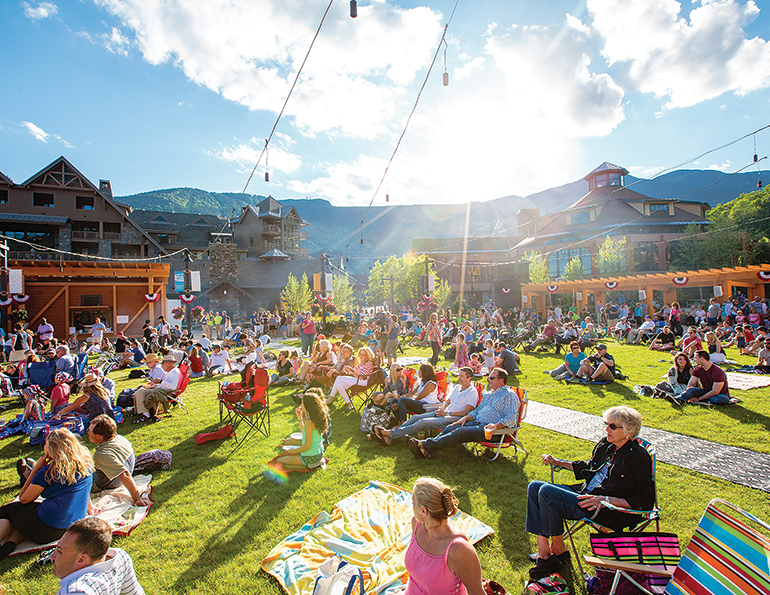 Green spaces can have multiple uses, including events, concerts, and other activities. Photo: Stowe Mountain Resort
Green spaces can have multiple uses, including events, concerts, and other activities. Photo: Stowe Mountain Resort
The Resort as a Mountain Oasis
Give ’em Some Shade!
The importance of shade can’t be overstated. Summer days are hot, and spending extended time in direct sunshine is uncomfortable. If you want visitors to linger and spend money, providing a comfortable environment is crucial.
• Plantings of deciduous trees provide natural dappled shade and help reduce the glare caused by sunshine reflecting off windows and light pavement.
• Shade structures such as pergolas can function as an extension of the resort’s architectural design.
• Umbrellas are a great option for providing shade at outdoor dining areas.
• In addition to shade, the use of darker, tinted pavements can help mediate the glare that reflects off typical concrete paving.
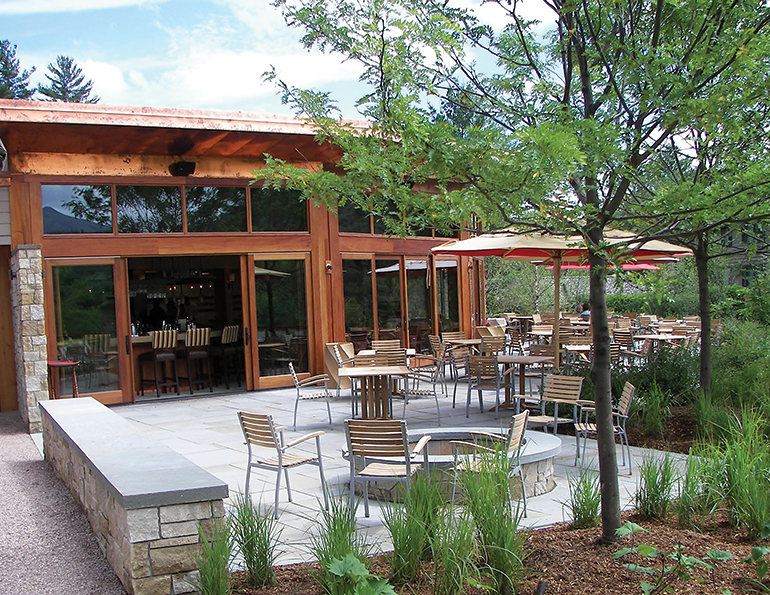 The importance of shade and places to sit cannot be overstated. Both encourage guests to linger, and thus increase spend.
The importance of shade and places to sit cannot be overstated. Both encourage guests to linger, and thus increase spend.
Capitalize on the View
Visitors will drive long distances for cool mountain air and dramatic scenery. Outdoor spaces should always be carefully designed to take advantage of the best views. By nature, humans (like many animals) enjoy sitting at sheltered edges that look out on open areas and distant views.
• Create comfortable “outdoor rooms” that provide some sense of enclosure and shade. The most popular outdoor seating areas also have attractive views.
• Low walls, benches, or outdoor chairs can provide seating. Stone-seat walls can be attractive design features, but backed benches are more comfortable for extended sitting.
• Great views and comfortable outdoor environments at F&B venues can draw visitors and extend the length of stay.
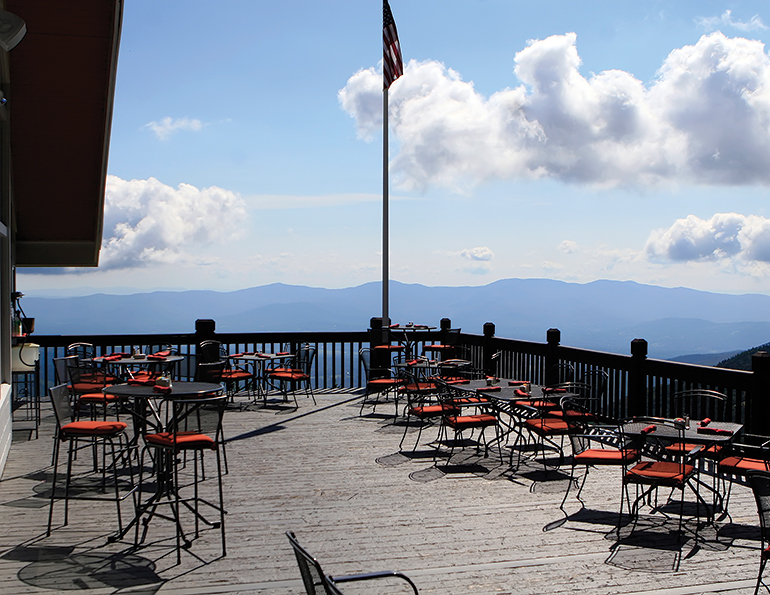 Mountain resorts have the built-in luxury of beautiful views, which people will drive great distances to enjoy.
Mountain resorts have the built-in luxury of beautiful views, which people will drive great distances to enjoy.
The Power of Water
People gravitate to water. While mountain runoff in the base area was once a liability—something to pipe underground and convey elsewhere—there is renewed appreciation for water as a potential amenity to attract guests.
• Natural streams, snowmaking ponds, even stormwater conveyances and treatment features present opportunities to enjoy this precious resource.
• Carefully design natural amenities to make them attractive, functional, and maintainable in all seasons.
• Daylighting a stream, by removing long stretches of underground culverts or pipes, can create a popular gathering place. Plus, a more natural condition is sure to please regulatory officials!
• Establish “beaches” by importing sand to the edge of snowmaking ponds. Add amenities such as F&B, volleyball courts, and seating to provide a fun
outdoor environment that attracts guests and generates revenue.
• Integrate features such as “pop-jet” fountains into paved areas. Such elements are popular for kids and adults alike, providing relief from hot weather, and they disappear in winter.
• Stormwater filtration/treatment infrastructure, such as constructed wetlands and rain gardens, can also be attractive and educational amenities.
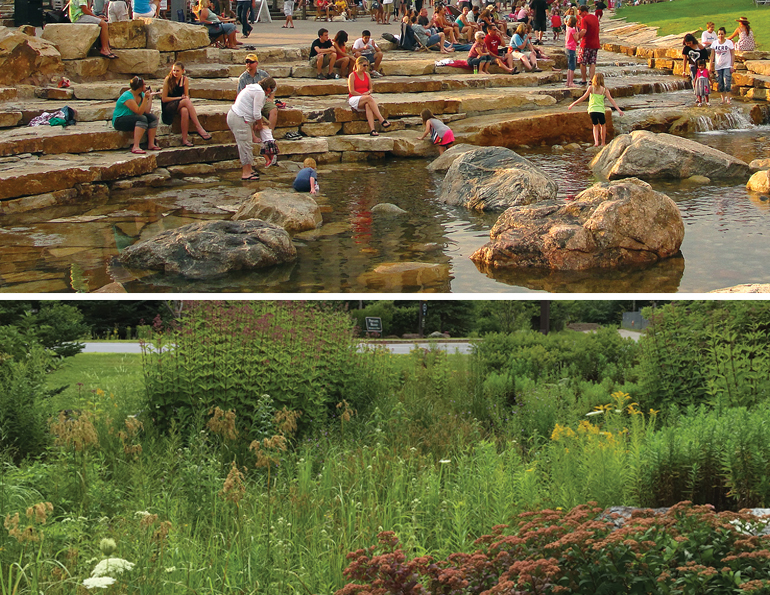 Going back to nature by daylighting a stream (top) or planting wildflowers in a meadow (bottom) has a variety of advantages.
Going back to nature by daylighting a stream (top) or planting wildflowers in a meadow (bottom) has a variety of advantages.
Because ski areas were created solely for winter activities, the look and feel of the spaces around base areas after the snow melts was never a primary design consideration. Now that guests are visiting mountain resorts year-round, give more thought to the design of these spaces. Comfortable and attractive resort environments that effectively integrate warm-season amenities create a positive experience for summer visitors. Extra attention to these design considerations can set your resort apart from the competition and encourage guests to stay longer and return often.





